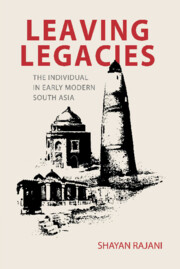1 - The Individual in the Inscription
Published online by Cambridge University Press: 28 November 2024
Summary
In light of recent scholarship, the Mughal age appears as a new and strikingly modern era of the prolix self. First, there is Babur's memoir, the Baburnama, penned in the early sixteenth century, which is recognized as an exceptional text in the Islamic and Indic worlds. This first-person narrative conveys a sense of individuality through emotional intensity, interiority, and acute observations of people and places around him. The memoir is characterized by both sincere self-disclosure and artful self-representation. Other men and women among Babur's descendants followed suit. Yet others began to compose first-person memoirs and travelogues in the seventeenth and eighteenth centuries.
In contrast, the practice of individuality described here extends beyond self-centered narrativization within texts. In fact, leaving legacies complicates each of the three characteristics typically associated with fashioning selfhood and individuality: textuality, narrativization, and self-centeredness. First, this practice spills out of texts and into epigraphy and architecture. Even in book manuscripts, it is often worked out on their margins and flyleaves. Together, this demands that the materiality of artifacts be taken seriously. It also requires close attention to the way these artifacts speak to and with each other in representing an individual across time and space. Second, legacies do not narrativize the self as autobiography, nor do they necessarily disclose interiority. Instead, they put forward a picture of an ethical self. Lastly, legacies deflect self-centeredness, choosing instead to be in service of others. The self appears on the margins of such works, obliquely, diffidently, but knowingly calling attention to itself without direct self-aggrandizement.
The legacy under review in this chapter is an epigraphical intervention by a Mughal noble upon a royal monument commissioned by the Mughal Emperor Babur (d. 1530). Locally known as the Chihilzina (Forty Steps), the monument is an arched grotto carved into the side of a mountain near Kandahar. Its inscriptional programs announce the direct involvement of four named individuals. Aside from Babur, this includes his second and third sons, Mirza Kamran (d. 1557) and Mirza Askari (d. 1558), who ruled Kandahar intermittently between 1530 and 1545. It also includes Mir Muhammad Masum (1528–1606), a Mughal noble from Sindh active in the late sixteenth century, who served Babur's grandson, Emperor Akbar.
- Type
- Chapter
- Information
- Leaving LegaciesThe Individual in Early Modern South Asia, pp. 26 - 48Publisher: Cambridge University PressPrint publication year: 2025

